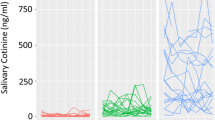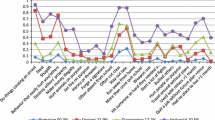Abstract
Situational factors and topographic features associated with smokeless tobacco use were examined. Male smokeless tobacco users (N=30) were asked to record the time, activity, and internal states associated with each dip of tobacco use over the course of 10 days. Additionally, these subjects were asked to record the activity and internal state they were experiencing every hour for a 15-hr waking period to obtain baseline rates of these events. Serum and saliva samples were obtained to measure cotinine concentrations. The activities significantly associated with smokeless tobacco use included after a meal, while driving, and while watching television. The internal states associated with smokeless tobacco use were feeling relaxed and depressed. Factor analysis of the events showed factors which are different from those found among cigarette smokers. Examination of the topographic measures of smokeless tobacco use showed that the total dip duration per day was 283.5 min, with a range of 79.7–757.1 min. This measure, along with duration of dipping time (time from onset to offset of smokeless tobacco use during the day), may be the best predictors of nicotine exposure.
Similar content being viewed by others
References
American Psychiatric Association (1980).Diagnostic and Statistical Manual of Mental Disorders, Third Edition (DSM III), APA, Washington, D.C.
Ary, D. V., Lichtenstein, E., and Severson, H. H. (1987). Smokeless tobacco use among male adolescents: Patterns, correlates, predictors, and the use of other drugs.Prevent. Med. 16: 385–401.
Ary, D. V., Lichtenstein, E., Severson, H., Weissman, W., and Seeley, J. R. (1989). An indepth analysis of male adolescent smokeless tobacco users: Interviews with users and their fathers.J. Behav. Med. 12: 449–467.
Ashton, I. T., and Stepney, R. (1982).Smoking: Psychology and Pharmacology, Tavistock, London.
Benowitz, N. C., Porchet, H., Sheiner, L., and Jacob, P., 3rd (1988). Nicotine absorption and cardiovascular effects with smokeless tobacco use: Comparison with cigarettes and nicotine gum.Clin. Pharmacol. Ther. 44: 23–28.
Benowitz, N. L., Jacob, P., 3rd, and Yu, L. (1989). Daily use of smokeless tobacco: Systemic effects.Ann. Intern. Med. 111: 112–116.
Best, J. A., and Hakstian, A. R. (1978). A situation specific model for smoking behavior.Addict. Behav. 3: 79–92.
Coan, R. W. (1973). Personality variables associated with cigarette smoking.J. Personal. Soc. Psychol. 26: 86–104.
Connolly, G. N., Winn, D. M., Hecht, S. S., Henningfield, J. E., Hoffman, D., and Walker, B., Jr. (1986). The reemergence of smokeless tobacco.N. Engl. J. Med. 314: 1020–1027.
Epstein, L. H., and Colins, F. L. (1977). The measurement of situational influences of smoking.Addict. Behav. 2: 47–53.
Gritz, E. R., Ippoliti, A., Jarvik, M. E., Rose, J. E., Shiffman, S., Harrison, A., and Van Vunakis, H. (1988). The effect of nicotine on the delay of gastric emptying.Aliment. Pharmacol. Ther. 2: 173–178.
Hatsukami, D. K., Gust, S. W., and Keenan, R. M. (1987). Physiologic and subjective changes from smokeless tobacco withdrawal.Clin. Pharmacol. Ther. 41: 103–107.
Hatsukami, D. K., Keenan, R. M., and Anton, D. J. (1988). Topographical features of smokeless tobacco use.Psychopharmacology 96: 428–429.
Hatsukami, D. K., Morgan, S. F., Pickens, R. W., and Champagne, S. E. (1990). Situational factors in cigarette smoking.Addict. Behav. 15: 1–12.
Ikard, F. F., and Tomkins, S. (1973). The experience of affect as a determinant of smoking behavior: A series of validity studies.J. Abnorm. Psychol. 81: 172–181.
Ikard, F. F., Green, D. E., and Horn, D. (1969). A scale to differentiate between types of smoking as related to the management of affect.Int. J. Addict. 4: 649–659.
McKennell, A. C. (1970). Smoking motivational factors.Br. J. Soc. Clin. Psychol. 9: 8–22.
National Cancer Institute (1989). Smokeless tobacco use in the United States, NIH Publication No. 89-3055, Bethesda, Md.
Pechacek, T. F. (1979). Modification of smoking behavior. In Krasnegor, N. A. (ed.),The Behavioral Aspects of Smoking, NIDA Research Monograph 26, U.S. Department of Health, Education and Welfare, Public Health Service, Alcohol, Drug Abuse, and Mental Health Administration, National Institute on Drug Abuse, pp. 127–188.
Peterson, A. V., Marek, P. M., and Mann, S. L. (1989). Initiation and use of tobacco in relation to smoking.Nat. Cancer Inst. Monogr. 8: 63–69.
Riley, W. T., Barenie, J. T., and Myers, D. R. (1989). Typology and correlates of smokeless tobacco use.J. Adolesc. Health Care 10: 357–362.
Riley, W. T., Barenie, J. T., Mabe, P. A., and Myers, D. R. (1990). Smokeless tobacco use in adolescent females: Prevalence and psychosocial factors among racial/ethnic groups.J. Behav. Med. 13: 207–220.
Schinke, S. P., Gilchrist, L. D., Schilling, R. F., and Senechal, V. A. (1986). Smoking and smokeless tobacco use among adolescents: Trends and intervention results.Public Health Rep. 101: 373–378.
U.S. Department of Health and Human Services (1986). The health consequences of using smokeless tobacco, NIH Publication No. 86-2874, Bethesda, Md.
Author information
Authors and Affiliations
Additional information
This research was funded by Grant DA05013 from the National Institute on Drug Abuse.
Rights and permissions
About this article
Cite this article
Hatsukami, D.K., Anton, D., Callies, A. et al. Situational factors and patterns associated with smokeless tobacco use. J Behav Med 14, 383–396 (1991). https://doi.org/10.1007/BF00845114
Accepted:
Issue Date:
DOI: https://doi.org/10.1007/BF00845114




